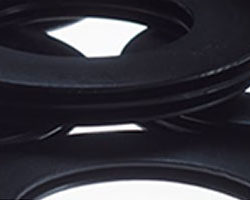
Description
Rubber-steel gaskets [G-ST] are used in bolted connections in which only low bolting forces can be realised. The elastomer properties allow on the one hand a very good adjustability to the sealing surface, on the other hand low leakage rates are achieved due to the homogeneous structure. The use of a centrally fitted, corrosion protected and vulcanised steel insert increases the blow-out resistance and stability. Therefore, the gasket is easy to handle even at large nominal widths. Extreme adhesion between steel insert and the rubber jacketing is ensured due to the vulcanisation. No moving, removal or even blow-out is possible even at the highest stress loads. The gaskets have a wide range of applications depending on the relevant elastomer and are suitable for water, water vapour, gas, air, acids, bases, hydrocarbons whilst application temperatures of up to 200 °C are possible. Rubber-steel gaskets [G-ST] are manufactured in various shapes according to the application area and the specified flange material [e.g. steel, FRP] and can be used in off- load and main load applications.